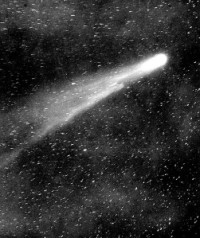A comet is a relatively small solar system body that orbits the Sun. When close enough to the Sun they display a visible coma (a fuzzy outline or atmosphere due to solar radiation) and sometimes a tail. The coma is created as the comet gets closer to the Sun, causing water, carbon dioxide and other compounds to sublime (quickly changing from solid to gas) from its surface. Comets are made of ice, dust and small rocky particles. The name comet comes from the Greek word meaning ‘hair of the head’, it came from the Greek philosopher Aristotle who observed comets as ‘stars with hair’. Short term comets (also known as periodic comets) have orbital periods of less than 200 years while long term comets have orbital periods of over 200 years.
Halley's Comet Halley’s Comet (or Comet Halley as it is also known) is the most well known comet. It is known as a periodic comet (or short term comet) because the time it takes to orbit the Sun is less than 200 years. Records of humans observing Halley’s Comet go back thousands of years, with appearances noted by Babylonian, Chinese and European star gazers. It can be seen with the naked eye from Earth every 75 to 76 years (although the time period has between 74 and 79 years in the past). It last appeared in the inner Solar System in 1986 and will return again sometime in 2061 (start charging your camera battery). Halley’s Comet is named after English astronomer Edmond Halley who first determined its period of orbit. It was the first comet to be recognized as having a periodic orbit. Halley’s Comet appearance in 1986 allowed researchers to investigate its make up more closely using spacecraft. While some previous theories were proven correct, other models were altered with the new information. For example, while earlier models predicted the comet to feature many volatile ices, the actual amount was less than first expected. The tail and fuzzy glow you see around Halley’s Comet is known as a coma. It occurs when the comet gets close to the Sun and compounds such as frozen water and carbon dioxide sublime (rapidly change from solid to gas) from its surface. While the coma over Halley’s Comet can stretch up to 100,000 km across, the nucleus is actually small, only around 15km (9.3 miles) long, 8km (5 miles) wide and 8km (5 miles) thick.
Comet Shoemaker-Levy 9 In July 1994, the Shoemaker-Levy 9 comet broke apart and collided with Jupiter. This event gave astronomers a unique opportunity to observe what happens when such a collision occurs. The largest fragments were 2 km (1.2 mi) in diameter and struck Jupiter at a speed of around 60 km/s (37 mi/s). The impact scars were clearly visible for months after the impact. Shoemaker-Levy 9 was originally located by astronomers Eugene M. and Carolyn Shoemaker and David Levy in March 1993.
| | |  | | More Space Facts: | | | | | Comet Facts | | | | | | | | | | | | | | |
|